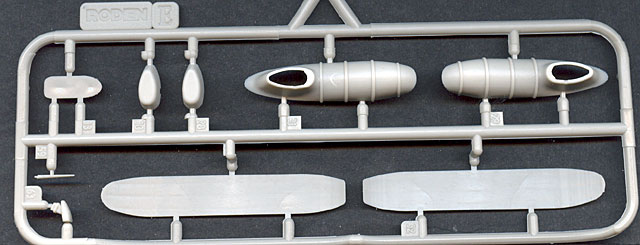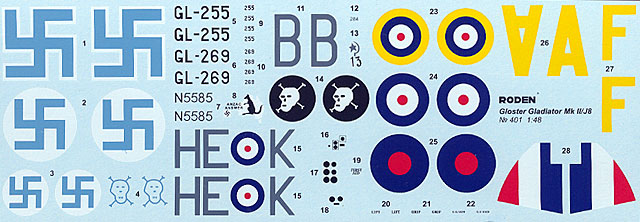S u m m a r y
|
| Catalogue
Number: |
RD401 |
| Scale: |
1/48 |
| Contents and Media: |
103 parts in light grey styrene;
6 parts in clear styrene; markings for five aircraft |
| Price: |
USD$20.97 from Squadron.com |
| Review Type: |
QuickLook |
| Advantages: |
Authentic surface texture;
parts for wheels and skis included; good details including cockpit and engine; positionable
flying surfaces; very thin trailing edges of flying surfaces; five marking options
including decals
for the tyres; extra parts also applicable to Sea Gladiator and
Gladiator Mk.I |
| Disadvantages: |
Some sink marks on fuselage; poorly shaped seat; mould flow lines on wings and
other smaller parts. |
| Recommendation: |
Recommended to early WWII RAF
and Finnish
and biplane aficionados. |
Reviewed by Brett Green

Roden's 1/48
Scale Gladiatorr Mk.II is available online from Squadron.com
Less than 12 months since the initial release of the Gladiator Mk.I,
Roden has released their third and final member of the Gladiator family,
the Mk.II.
In my opinion, Roden has left the best until last. If you have not
bought a Roden 1/48 scale Gladiator yet, this is the one to get. All the
parts from both the Gladiator Mk.I and Sea Gladiator are included in this
box, plus a new sprue with skis for the Finnish options. Even with this
bonus parts bonanza, the price of this version is actually lower than the
earlier two kits were on their release! A second style of windscreen has
also been supplied.
The other relevant news is that True Details released a cockpit detail
set for the Gladiator Mk.II earlier this year. This resin set provides
even nicer detail in this prominent area, and even more importantly
replaces the awful kit seat.
Roden's 1/48 scale Gladiator Mk.II comprises 103 parts in light beige styrene,
and an additional 6 parts in clear.
In common with the earlier kits, the parts are generally well moulded, and surface texture is very
impressive. The fabric over ribs looks just right. Panel lines, where
appropriate, are crisply engraved. Depiction of rib tape on the ailerons
is so subtle as to be almost invisible! There are a few sink marks and
stress lines on the outside of the fuselage. These are partly the result
of ambitious moulding of structural detail on the inside of the fuselage.
There are some bigger sink marks on the front face of the propeller blade
too. These will need some attention with putty and a sanding stick. Mould
flow lines are present on the wings and tailplanes, but they will
disappear under a coat of paint.

Locating pins are not widespread on the kit but engineering is robust.
Large tabs help locate the lower wing to each fuselage half, and the upper
wing is supplied as a single, full span part. The trailing edges on the
three wing parts are almost razor sharp - very impressive. Furthermore,
there are locating pins for the top and bottom of the outer struts
on each wing. The cabane struts are secured with locating pins too. All
the flying
surfaces are supplied as separate parts.
Some of the parts are incredibly fine and delicate. Of special note is
Part 68, the fin mast for the aerial wire. The trigger on the control
column and the pitot tubes moulded to the port strut are worthy of
attention too.
The engine is made up of 26 pieces not including the propeller, cowl
and filter. This should look great when finished, but care must
be taken to ensure that it will fit in the three-piece cowl.
Click the thumbnails below
to view larger images:



The cockpit is also convincing. Raised structural detail is present on
the sidewalls, and the impression of the partial floor is captured quite
well. The instrument panel is a clear part with decal instruments applied
to the rear. The same awful slab-like seat is still offered though.
The new sprue this time contains eight parts for the skis and a new
radio mast..

The arrestor hook and three bladed Fairey propeller are still included.
The decals look very good. Markings for six Gladiator MkIIs - two
British and four Finnish. The painting instructions for three of the
Finnish options suggest a disruptive overspray of silver over the
camouflage colours. If correct, that would be an interesting look!

Instructions are called out over 18 steps using diagrams. Paint
references are supplied for Humbrol, Testor, Gunze and Lifecolor. Each
marking option is covered using a side profile plus upper and lower plan
view. Separate rigging diagrams for the RAF and Finnish subjects completes the package.
Roden's 1/48 scale Gladiator Mk.II looks every bit as nice
as its two predecessors.
In common with the earlier versions, careful preparation and test fitting is the best formula
for avoiding problems. In particular, I would recommend that the basic
engine part is test-fitted to the assembled cowl, and that the engine is
test fitted repeatedly after each extra component is added. The cockpit
components should be test-fitted in the fuselage to check width before
painting and assembly too.
A little
time and care, and a replacement seat, will render a terrific result
from this impressive kit.
Recommended.
Review and Images Copyright © 2003 by
Brett Green
Page Created 10 November, 2003
Last updated 10 November, 2003
Back to HyperScale Main Page
Back to Reviews Page
|
Home | What's
New | Features
| Gallery |
Reviews | Reference
| Forum
| Search